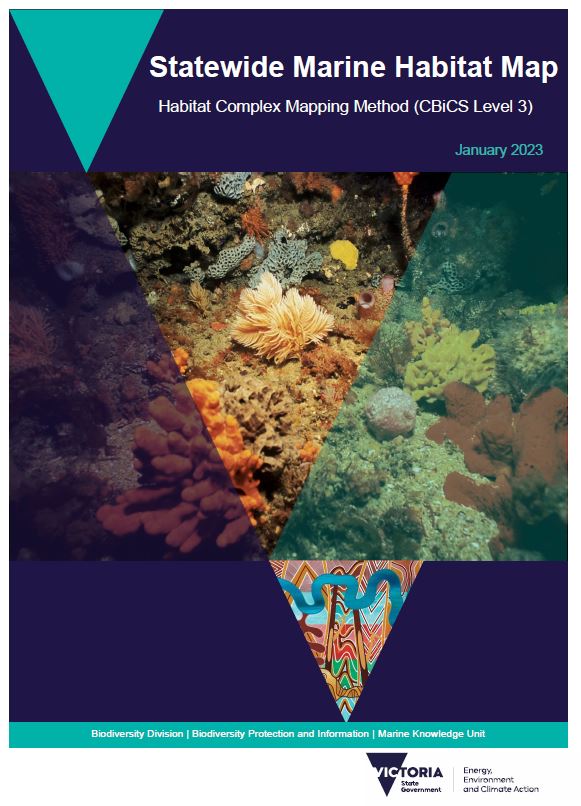Creating the Marine Habitat Map
Unlike terrestrial landscapes, mapping marine habitats presents numerous challenges given the costs, logistics and limitations of accessing the ocean. The best techniques for marine habitat mapping rely upon predicting where habitats are located from existing information.
The statewide marine habitat map was created from available habitat observations recorded in Victoria’s waters, combined with predictive modelling and mapping techniques that synthesis existing information. The below steps outline the process of creating the marine habitat map.
The building blocks of the habitat map are 32,998 locations across state waters where habitats have been physically observed and recorded (i.e. ground-truth records). Habitat observations have been included from a variety of sources including localised habitat mapping, monitoring programs, impact assessments and historical surveys, and have been classed according to Victoria’s Combined Biotope Classification Scheme (CBiCS). All habitat observation records are available from the ‘Biotope Atlas Tool’ in CoastKit.
Twenty-eight environmental properties that are considered related to habitat characteristics were incorporated into the modelling process. These included bathymetry, productivity, temperature, sediments, waves and currents. Environmental properties were mapped at a high resolution across the state and assisted the model to predict where habitats occur.
To predict the distribution of habitats across Victorian waters the powerful Random Forest machine learning algorithm was applied. Random Forest is considered an effective modelling method for marine habitats and biodiversity with high performance and application across the globe.
Existing marine habitat maps that provide high resolution mapping across small sections of the state were integrated into the statewide map. The final map comprises 83% of habitat area from predictive habitat modelling (Step 3), with the remaining 17% from former habitat maps.
The statewide habitat map represents 24 distinct habitats (CBiCS Level 3). Importantly, these 24 habitats encompass a range of species, some of which may be unique, rare or vulnerable. Victoria’s waters comprise a diversity of habitats, with the open coast dominated by sand and muddy sand with patches of infralittoral rock. The central open coast features rhodolith beds, with rocky habitats characterising the western coast in contrast to the eastern coast with vast sand and mixed sediment habitats. Victoria bays, and inlets are a complex assemblage of habitats, with coastal saltmarsh and reedbeds, mangroves, muddy habitats, communities of macroalgae, and significant seagrass beds across Port Phillip Bay, Western Port and Corner Inlet.
Description of 24 Habitat Types
The following tables provide habitat descriptions for all Biotopes (habitat complexes) and CBiCS level 3 used in the assessment.
| Biotic code | Habitat complex | Description | Key |
|---|---|---|---|
| ba1.1 | High energy littoral rock | Shores of bedrock, boulder, cobble, and artificial hard substrata, either extremely exposed or exposed to breaking swell waves. Occur in the intertidal zone and the splash zone from the top of the lichen, supralittoral zone and to the lowest astronomical tide (LAT), sublittoral fringe. Further distinguished |  |
| ba1.2 | Moderate energy littoral rock | Moderately exposed shores (bedrock, boulders, and cobbles) and other hard substrata. Includes shores that are exposed to swell surge and low swell waves but not directly exposed to breaking swell waves. Occur in the intertidal zone and the splash zone from the top of the lichen, supralittoral zone and |  |
| ba1.3 | Low energy littoral rock | Sheltered to ultra-sheltered rocky shores with very weak to weak tidal streams. Includes bedrock, boulders, cobble, and other hard substrata. Occur in the intertidal zone and the splash zone from the top of the lichen, supralittoral zone and to the LAT, sublittoral fringe. Further distinguished at Levels |  |
| Biotic code | Habitat complex | Description | Key |
|---|---|---|---|
| ba2.1 | Littoral coarse sediment | Littoral coarse sediments include shores of mobile pebbles, cobbles, and gravel, with varying amounts of coarse sand. Sediment is highly mobile and subject to high degrees of drying between tides. As a result, few species can survive in this environment: beaches of mobile cobbles and pebbles tend to |  |
| ba2.2 | Littoral sand | Littoral sand, in the intertidal zone and the splash zone from the top of the lichen, supralittoral zone and to the LAT, sublittoral fringe. |  |
| ba2.3 | Littoral mud | Littoral mud, in the intertidal zone and the splash zone from the top of the lichen, supralittoral zone and to the LAT, sublittoral fringe. |  |
| ba2.5 | Saltmarsh and reedbeds | Saltmarsh and reedbeds. Further distinguished at Levels 4 and higher by type (like grassland, shrubland, saltmarsh), dominant species, location (such as estuarine or coastal) and degree of inundation (such as wet or dry). |  |
| ba2.6 | Mangrove | Mangrove habitat, further distinguished at Levels 4 and higher by habitat type (such as wetland or shrubland), dominant species, location (such as estuarine or coastal) and degree of inundation (wet or dry). |  |
| ba2.7 | Littoral sediment seagrass | Sward-forming aquatic herbland of sheltered marine shallows, intertidal flats and lower estuarine habitats. Dominated by Grass-wracks or Sea-grasses (Zostera muelleri ssp. muelleri and Z. muelleri ssp. capricornii and/or Zostera nigricaulis and Z. tasmanica s.l.), often monospecific and sometimes in close extends into lower estuarine proximity to Avicennia marina (White Mangrove) stands. Zostera muelleri |  |
| Biotic code | Habitat complex | Description | Key |
|---|---|---|---|
| ba3.1 | High energy infralittoral rock | High energy rock and other hard substrata, including gravel, cobble and boulders found below the low tide mark extending to the lower limit of dense seaweed growth. Further distinguished at Levels 4 and higher by cover type or dominant algal species. |  |
| ba3.2 | Moderate energy infralittoral rock | Moderate energy rock and other hard substrata, including gravel, cobble and boulders found below the low tide mark extending to the lower limit of dense seaweed growth. Further distinguished at Levels 4 and higher by cover type or dominant algal species. |  |
| ba3.3 | Low energy infralittoral rock | Low energy rock and other hard substrata, including gravel, cobble and boulders found below the low tide mark extending to the lower limit of dense seaweed growth. Distinguished at Levels 4 and higher by cover type or dominant algal species. |  |
| Biotic code | Habitat complex | Description | Key |
|---|---|---|---|
| ba4.1 | High energy open-coast circalittoral rock | High energy open-coast circalittoral rock found below the algal-dominated infralittoral, dominated by animal communities typically comprised of a mosaic of species. Distinguished at Level 4 by additional cover type, like sandy, or by dominant species, and at Level 5 by location. |  |
| ba4.2 | Tide-swept channels of circalittoral rock | Animal-dominated communities below the algal-dominated infralittoral, typically comprised of a mosaic of species, found within channels, and narrows areas. Subject to strong tidal flows with high to moderate current and wave energy. Distinguished at Level 4 by substrate or dominant species, and at Level |  |
| Biotic code | Habitat complex | Description | Key |
|---|---|---|---|
ba5.1 | Sublittoral coarse sediment | Coarse sediments in the near shore zone including coarse sand, gravel, pebbles, shingle, and cobbles which are often shingle, due to tidal currents and/or wave action. Generally found on the open coast or in tide-swept channels of marine inlets and having a low silt content. Typically lacking a significant seaweed component and characterised by a robust fauna including venerid bivalves. Distinguished at Level 4 and higher by sediment type or bedform. | 
|
ba5.2 | Sublittoral sand and muddy sand | Clean medium to fine sands or non-cohesive slightly muddy sands in the near shore zone on open coasts, offshore or in estuaries and marine inlets. Often subject to a degree of wave action or tidal currents which restrict the silt and clay content to less than 15%. Characterised by a range of taxa including polychaetes, bivalve molluscs, and amphipod crustacea. Distinguished at Levels 4 and higher by variability of salinity, surface bedforms like ripples, or by epifaunal structures like burrow mounds. | 
|
ba5.3 | Sublittoral mud | Sublittoral mud and cohesive sandy mud extending from the extreme lower shore to offshore, circalittoral habitats. Predominantly found in sheltered harbours, marine inlets and estuaries, and stable deeper/offshore areas. Often by dominated by polychaetes and echinoderms like brittlestars. Seapens such as Virgularia mirabilis and burrowing megafauna are common in deeper muds. Estuarine muds often characterised by infaunal polychaetes and oligochaetes. Distinguished at Levels 4 and higher by variability of salinity, surface bedforms like ripples, or by epifaunal structures like burrows. | 
|
ba5.4 | Sublittoral mixed sediments | Sublittoral mixed (heterogeneous) sediments found from the extreme low water mark to deep offshore circalittoral habitats, including heterogeneous muddy gravelly sands and mosaics of cobbles and pebbles embedded in or lying upon sand, gravel, or mud. May support a wide range of infauna and epibiota including polychaetes, bivalves, echinoderms, anemones, hydroids and Bryozoa. Mixed sediments with biogenic reefs or macrophyte dominated communities are classified separately. Distinguished at Levels 4 and higher by variability of salinity, dominant sediment or species type. | 
|
ba5.5 | Sublittoral rhodolith beds | Beds of rhodoliths (maerl) in coarse clean sediments of gravels and clean sands from the extreme low water mark to deep offshore circalittoral habitats. Distinguished at Levels 4 as either on the open coast or in tide-swept channels of marine inlets (the latter often stony). | 
|
ba5.6 | Sublittoral biogenic reefs | Includes polychaete reefs, bivalve reefs (e.g. mussel beds) and cold water coral reefs from the extreme low water mark to deep offshore circalittoral habitats. Communities develop in a range of habitats from exposed open coasts to estuaries, marine inlets, and deeper offshore habitats and in a variety of sediment types and salinity regimes. This does not include tropical coral reefs. Distinguished at Levels 4 and higher by dominant habitat-forming species groups and species. | 
|
ba5.7 | Sublittoral seaweed on sediment | Shallow sublittoral sediments which support seaweed communities, including various red and brown seaweeds, particularly fine and filamentous types. The generally sheltered nature of these habitats enables the seaweeds to grow on shells and small stones which lie on the sediment surface. Includes communities developed as loose-lying mats on the sediment surface and also termed drift algal mats. Distinguished at Levels 4 and higher by dominant species groups and species. | 
|
ba5.8 | Sublittoral seagrass beds | Beds of submerged marine angiosperms such as in the genera Cymodocea, Halophila, Posidonia, Ruppia, Thalassia, Zostera. Distinguished at Levels 4 and higher by dominant habitat-forming species groups and species. | 
|
ba5.b | Non-reef sediment epibenthos | Mixed sublittoral sediments with a substantial cover of epibenthic biota that are not biogenic reef forming, including scallop beds, seapen beds and low densities of Pyura and other ascidians. Distinguished at Levels 4 and higher by dominant species groups and species. |  |
Applying the Marine Habitat Map
The statewide map provides broad knowledge of 24 marine and coastal habitat types across the state to support:
- Large-scale habitat management (>25m)
- Habitat condition assessments
- Marine Spatial Planning
- Strategic Management Prospect (SMP)
- Feature Activity Sensitivity Tool (FeAST) risk assessments
The map provides fundamental knowledge for management decisions across Victoria's marine and coastal waters, and a baseline of information for future data to build upon.
Page last updated: 17/04/24
